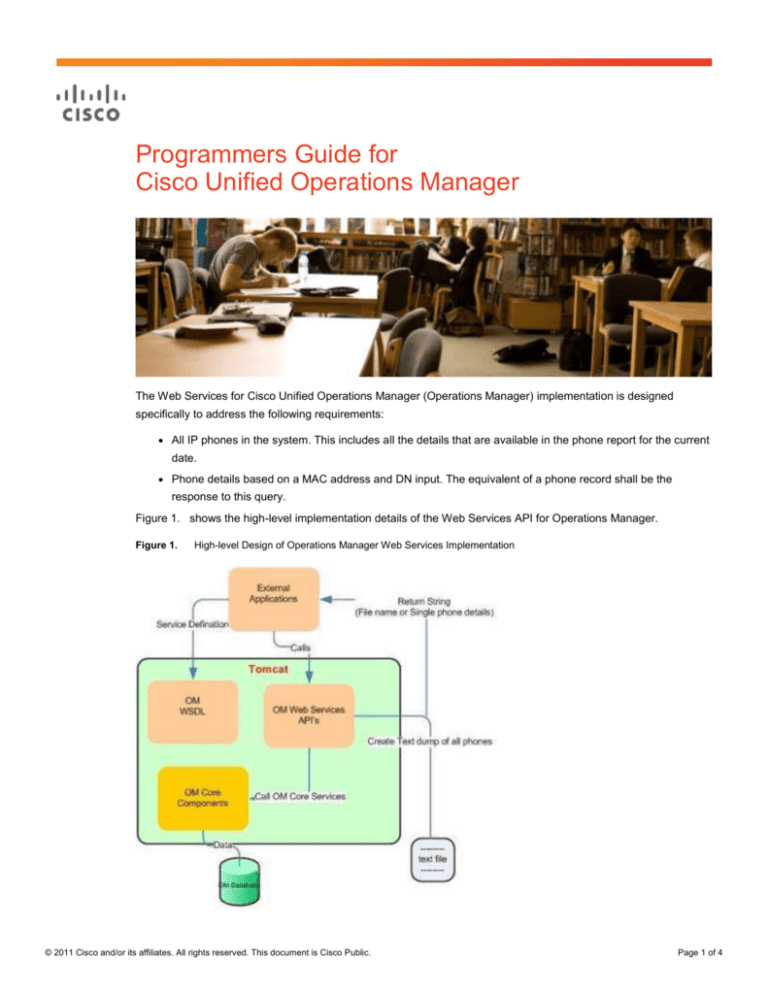
Programmers Guide for
Cisco Unified Operations Manager
The Web Services for Cisco Unified Operations Manager (Operations Manager) implementation is designed
specifically to address the following requirements:
●
All IP phones in the system. This includes all the details that are available in the phone report for the current
date.
●
Phone details based on a MAC address and DN input. The equivalent of a phone record shall be the
response to this query.
Figure 1. shows the high-level implementation details of the Web Services API for Operations Manager.
Figure 1.
High-level Design of Operations Manager Web Services Implementation
© 2011 Cisco and/or its affiliates. All rights reserved. This document is Cisco Public.
Page 1 of 4
The following are the supported services in Operations Manager:
Operations Manager Web Services Description Language (WSDL)
This is the primary service definition for all the Web Services provided in the Operations Manager. A client program
can look up the service definitions, which provide the details for each service, such as the operation name, input,
and output of a service.
Operations Manager Web Services API
This is the actual implementation of the Web Services. This implementation is based on the Apache Axis Web
Services platform, which is part of Common Services. The implementation uses core Operations Manager API calls
to perform any desired operations.
To get information on all phones in Operations Manager, the API:
1.
Looks up for the phone information by calling the core Operations Manager APIs.
2.
Writes this information on a text file (shown in Figure 1. ).
3.
Returns a string that provides the location and the file name.
Every time the API overwrites the previous text file, so there is no purging APIs or disk clean up required. The text
file can be picked up offline by the calling program and the last created text file will always be available.
In case the calling program needs a particular phone, the phone details are returned as string. All the
communication will be done using Simple Object Access Protocol (SOAP).
The implementation follows all the standard Web Services guidelines, to make it easy for the external programs to
interoperate with the APIs.
Service Details and Example
The service name to get all phones is getAllPhones(). This service returns the allomphones.csv string file name.
The service name for getting information about a particular phone is getOMPhone(String MACAddress). This
service returns a comma delimited string which has the same structure as the CSV file.
The service writes a CSV file with all the phone data and this CSV file is located at
NMSROOT\data\allomphones.csv. NMSROOT is the folder where Operations Manager is installed on the server.
The following is the structure of the CSV file for parsing it:
PhoneNumber, CCMName, VlanName, CCMAddress, IPAddress, UnregisteredTime, ExtnNumber,
SwitchPortStatus, LineStatus, LastSeen, SwitchPortName, Status, DevicePoolIndex, SwitchAddress, Protocol,
SwitchPort, AppId, SRSTRouter, PhoneTimeLastRegistered, VideoEndPoint, PhoneDescr, SRST, CCMType,
SwitchName, LoadId, PhoneFailCause, VlanType, SerialNo, VlanId, MACAddress
© 2011 Cisco and/or its affiliates. All rights reserved. This document is Cisco Public.
Page 2 of 4
Code Sample to Call the Web Service
OMServiceIf iface
// The interface name for the service.
public void setUp(){
String host = <Your Host IP>;
// Get certificate
GetCert.fetchAndShowCertificate(host,443);
// Login
Your code to log in to the Operations Manager Server with the security
certificate.
if(secSvc.login()) {
}
// Get a handle to the Operations Manager service.
URL url =null;
try {
url = new URL("http://" + host + ":1741/iptm/services/OMService"); //
Default URL for Web Services
} catch (MalformedURLException e) {
// TODO Auto-generated catch block
e.printStackTrace();
}
try {
iface = (OMServiceIf)new
com.cisco.nm.trx.websvc.server.OMServiceIfServiceLocator().getOMService(url);
}
catch (javax.xml.rpc.ServiceException jre) {
if(jre.getLinkedCause()!=null)
jre.getLinkedCause().printStackTrace();
throw new junit.framework.AssertionFailedError("JAX-RPC
ServiceException caught: " + jre);
}
Service Call for All Phones
String filename = iface.getAllPhones();
// Returns the filename. If the file name is returned, then the call is
successful. The CSV file is available on the Operations Manager Server under
NMSROOT/data folder.
© 2011 Cisco and/or its affiliates. All rights reserved. This document is Cisco Public.
Page 3 of 4
Service Call for One Phone
String phoneData = iface.getOMPhone(<MAC Address>);
// Returns the single phone details as a comma delimited string that matches the
MAC address.
© 2011 Cisco and/or its affiliates. All rights reserved. This document is Cisco Public.
Page 4 of 4







